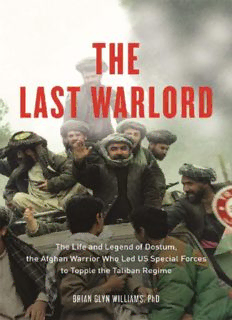
The Last Warlord: The Life and Legend of Dostum, the Afghan Warrior Who Led US Special Forces to Topple the Taliban Regime PDF
Preview The Last Warlord: The Life and Legend of Dostum, the Afghan Warrior Who Led US Special Forces to Topple the Taliban Regime
Copyright © 2013 by Brian Glyn Williams All rights reserved Published by Chicago Review Press, Incorporated 814 North Franklin Street Chicago, Illinois 60610 ISBN 978-1-61374-800-8 Interior design: PerfecType, Nashville, TN Library of Congress Cataloging-in-Publication Data Williams, Brian Glyn. The last warlord : the life and legend of Dostum, the Afghan warrior who led US special forces to topple the Taliban regime / Brian Glyn Williams, PhD. pages cm Summary: “In The Last Warlord, scholar Brian Glyn Williams takes Westerners inside the world of general Abdul Rashid Dostum, one of the most powerful of the Afghan warlords who have dominated the country since the Soviet invasion. Based on lengthy interviews with Dostum and his family and subcommanders, as well as local chieftains, mullahs, elders, Taliban enemies and prisoners of war, and women’s rights activists, The Last Warlord tells the story of Dostum’s rise to power from peasant villager to the man who fought a long and bitter war against the Taliban and Al Qaeda fanatics who sought to repress his people. The book details how, after 9/11, the CIA contacted the mysterious Mongol warrior to help US Special Forces wage a covert, horse-mounted war in the mountains of Afghanistan that ended in a stunning victory; how Dostum was later marginalized by US and Afghan leaders; and how sensational media accounts have made him the object of rampant mythologizing. With the United States drawing down troops in 2014 and Dostum poised to re-enter the world stage to fight a resurgent Taliban, The Last Warlord provides important historical context to the controversy swirling around Afghanistan’s warlord culture and is an essential contribution to the debate on Afghanistan’s future”-- Provided by publisher. ISBN 978-1-61374-800-8 (hardback) 1. Dustum, ‘Abd al-Rashid, 1954– 2. Afghanistan—Politics and government—1989–2001. 3. Afghanistan—Politics and government—2001– 4. Warlord-ism—Afghanistan —History 5. Taliban. I. Title. DS371.33.D8W55 2013 958.104’742092--dc23 [B] 2013008742 Printed in the United States of America 5 4 3 2 1 For my friends from Indiana, Wisconsin, and London: Forbes McIntosh, Chuk Starett, Dominique Lawrenz, Sean Buckman, Ed Lee, Mike Waterfield, Ray Szylko, Mikol Forth, Shane and Ben Soldinger, Chee McCardle, Jake Blavat, Mike McCue, Anton Garcia, Colleen Kanzora, and Carrie Jacob. “It’s time for a new generation who don’t have blood on their hands to build our nation. Perhaps it is fitting that I am my people’s last warlord.” —GENERAL ABDUL RASHID DOSTUM CONTENTS ________________ Maps Preface Chronology 1 The Warlord of Mazar 2 How to Meet a Warlord 3 The Approaching Storm 4 Raiders 5 Last Line of Defense 6 The Evil Comes to America 7 Search for a Plan 8 Khoja Doko Village, 1954 9 The First Battles 10 The Soldier 11 The Traitor 12 Khadija 13 Conspiracies 14 The Warlord 15 The Coup 16 Malik 17 The Americans 18 The Offensive Begins 19 Interview with a Warlord Epilogue Acknowledgments Notes Index PREFACE ________________ R ESEARCHING THIS BOOK on General Abdul Rashid Dostum (pronounced Doe-STUM), one of Afghanistan’s most powerful and controversial warlords, was the greatest challenge of my life. To collect Dostum’s story I traveled to Afghanistan four times and crossed fifteen of its war-torn provinces. There I interviewed Taliban prisoners of war, anti-Taliban field commanders, newly liberated Afghan women, US soldiers, village elders, and General Dostum himself. The most difficult task I faced was getting my subject to open up and tell me his story. Some of the difficulties came from Dostum’s reluctance to share his account of hidden intrigues, bygone legends, and past betrayals with an outsider like me. In Afghan-Uzbek warrior culture, victories and personal triumphs are celebrated; personal tragedies, dark secrets, and defeats are not. Other difficulties stemmed from Dostum’s background as an Afghan fighting man. His mind was focused on the logistics and immediacy of warfare, not his role in the greater flow of history. While Dostum might remember the effects of a B-52 bomber clearing Taliban from the path of an Uzbek cavalry charge, he typically forgot the number of horsemen riding alongside him. The very specifics that are the lifeblood of a historian are of little consequence to those focused on staying alive in battle. While Afghans I spoke with were wonderful storytellers, they rarely offered the linear, fact-filled history Westerners expect. For these reasons the story of Dostum’s rise to power, love of a woman, betrayal, and phoenixlike resurrection to free his people from the Taliban doubtless contains stories that are half legend. But for all their flaws, these accounts are a unique historical record and provide the bones for this story. I should also point out that I am a historian by training, not an investigative journalist, so I was not able to fully investigate all of the mysteries concerning Dostum’s remarkable life. Considering the difficult conditions I was working in, there are bound to be questions about Dostum that I have not been able to
Description: